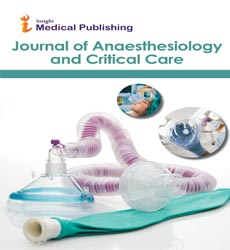General Sedative Activity and Premedication
Shihab Steven Yule*
Department of Neurosurgery, Federal University of Triângulo Mineiro (UFTM), Uberaba, MG, Brazil
- *Corresponding Author:
- Shihab StevenYule
Department of Neurosurgery, Federal University of Triângulo Mineiro (UFTM), Uberaba, MG, Brazil
E-mail: sahihabyule@gmail.com
Received Date: November 25, 2021; Accepted Date: December 09, 2021; Published Date:December 16, 2021
Citation: StevenYule S (2021) General Sedative Activity and Premedication. J Anaesthesiol Crit Car. Vol.4 No.2:08
Perspective
General sedation or general sedation (see spelling contrasts) is a medicinally persuaded unconsciousness with loss of guarded repugnancies, performing from the organization of one or further broad sedative specialists. It's by and large acted in a working auditorium to permit surgeries that would else be underhandedly excruciating for the case, or in a brutal consideration unit or exigency division to lube mechanical ventilation in basically sick cases. Two significant advances happened in the late nineteenth century, which together permitted the change to present day medical procedure. An enthusiasm for the microbe hypothesis of illness drove quickly to the turn of events and utilization of sterile methods in medical procedure. Antisepsis, which before long gave way to asepsis, diminished the general horribleness and mortality of medical procedure to an undeniably more OK rate than in past periods. Simultaneous with these improvements were the huge advances in pharmacology and physiology which prompted the improvement of general sedation and the control of agony. Inhalational sedative substances are either unpredictable fluids or gases, and are generally conveyed utilizing a sedation machine. A sedation machine permits making a blend out of oxygen, sedatives and encompassing air, conveying it to the patient and observing patient and machine boundaries. Fluid sedatives are vaporized in the machine. Acceptance and support of general sedation, and the control of the different physiological aftereffects is normally accomplished through a combinatorial medication approach. Individual general sedatives fluctuate regarding their particular physiological and intellectual impacts. While general sedation enlistment might be worked with by one general sedative, others might be utilized in equal or consequently to accomplish and keep up with the ideal sedative state. The medication approach used is subject to the methodology and the necessities of the medical services suppliers. Atomic constructions of general sedatives broadly utilized in medication are extremely straightforward and different so that there is no undeniable design action relationship[1] (see constructions of general sedatives broadly utilized in medication: 1 - ethanol, 2 - chloroform, 3 - diethyl ether, 4 - fluroxene, 5 - halothane, 6 - methoxyflurane, 7 - enflurane, 8 - isoflurane, 9 - desflurane, 10 - sevoflurane).Most broad sedatives have amazingly powerless partiality for their objectives acting at a lot higher focuses than most different medications with the goal that assorted secondary effects are unavoidable. Preceding an arranged system, the anesthesiologist audits clinical records as well as meetings the patient to decide the best mix of medications and measurements and how much observing will be needed to guarantee a protected and successful technique. Key elements in this assessment are the patient's age, weight record, clinical and careful history, current meds, and fasting time. Exhaustive and precise responding to of the inquiries is significant with the goal that the anesthetist can choose the appropriate medications and systems. For instance, a patient who devours critical amounts of liquor or unlawful medications could be under medicated assuming they neglect to unveil this reality, and this could prompt sedation mindfulness or intraoperative hypertension. Commonly utilized meds can cooperate with sedatives, and inability to reveal such utilization can build the danger to the patient. One ordinarily utilized premedication is clonidine, an alpha-2 adrenergic agonist. Clonidine premedication decreases the requirement for sedative acceptance specialists, for unpredictable specialists to keep up with general sedation, and for postoperative analgesics. It likewise lessens postoperative shuddering, postoperative queasiness and regurgitating, and rise delirium. In kids, clonidine premedication is essentially pretty much as compelling as benzodiazepines and has less genuine side effects. However, oral clonidine can require as long as 45 minutes to take full effect and downsides incorporate hypotension and bradycardia.
Open Access Journals
- Aquaculture & Veterinary Science
- Chemistry & Chemical Sciences
- Clinical Sciences
- Engineering
- General Science
- Genetics & Molecular Biology
- Health Care & Nursing
- Immunology & Microbiology
- Materials Science
- Mathematics & Physics
- Medical Sciences
- Neurology & Psychiatry
- Oncology & Cancer Science
- Pharmaceutical Sciences
